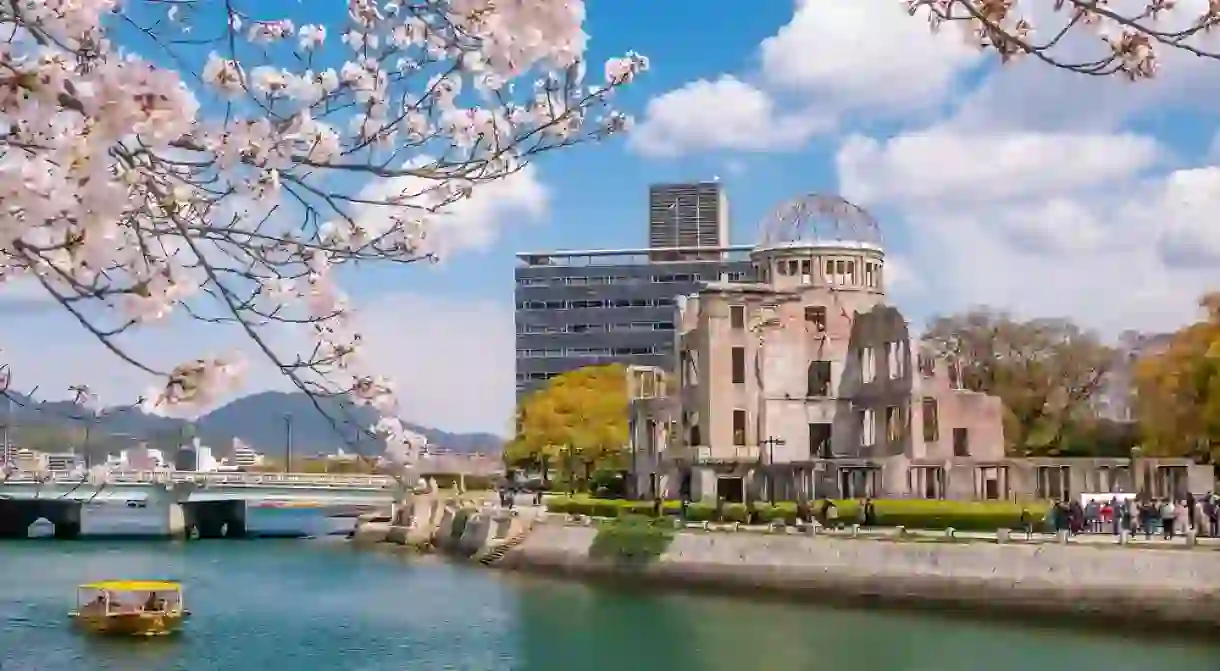The Most Unusual Experiences in Hiroshima

Hiroshima is famous for its solemn history, its UNESCO World Heritage Sites, and its delicious seafood and regional cuisine. But once you’ve explored the Peace Memorial, seen the sights, and eaten your fill of local foods, there are still plenty of fascinating and unusual things to see and do in Japan‘s famous city.
>> Looking for the best experiences in Hiroshima? Check out some of these tours!
Check out the world’s largest rice scoop on Miyajima Island
Shrine

Miyajima is one of Japan’s most popular destinations thanks to Itsukushima Shrine, famed as one of three most scenic landmarks in Japan. However, Miyajima offers other interesting sights including the world’s largest shamoji, or rice scoop, displayed on the island’s Omotesando shopping street. Made of Japanese elm and weighing 2.5 metric tons, this giant shamoji was made to commemorate Itsukushima Shrine being designated a UNESCO World Heritage Site in 1996. A short distance from the giant rice scoop is a workshop where you can decorate and send your very own wooden rice scoop postcard.
Visit the home of artisan calligraphy and makeup brushes
Museum

Kumano City is the artisanal brush capital of Japan. This small town, located to the east of Hiroshima City, produces around 80% of Japan’s calligraphy brushes using centuries-old techniques. The handcrafted brushes, called fude, are made from natural materials including Japanese woods and animal fur. While they are primarily crafted for Japanese calligraphy, in recent years Kumano brushes have become popular for use as high-end makeup brushes. Kumano celebrates their local craft with the Fude Matsuri (Brush Festival) held on the autumnal equinox each year. Visitors to Kumano should check out the Fudenosato Kobo Museum, where you can see Kumano brushes being made and even attend a brush making workshop.
Escape to an island of rabbits
Museum

Okunoshima, or ‘Rabbit Island’, is located about two hours by local train from Hiroshima City, the perfect distance for a day trip. The island was once a secret government testing facility for poison gas, and after the facility was shut down, healthy test rabbits were released from the lab. While Okunoshima is also home to the educational Poison Gas Museum, the biggest draw for visitors are the hundreds and hundreds of wild, yet friendly bunnies that roam free. You can get there by ferry from Tadanoumi Port.
Take a stroll down ‘Cat Alley’
Museum
If you’re more of a cat than a rabbit person, then head to Onomichi for its famous Neko no Hosomichi, or ‘Cat Alley’. The narrow street built into one of the town’s hillsides has 108 round painted stone cats called ‘fukuishi-neko’ located at various points along its path. It’s also home to the Maneki-neko Museum, dedicated to the ‘beckoning cat’ figures which are said to bring good fortune to their owner. As you walk the trail, you are sure to spot one of the hillside’s four-legged guardians watching over you. If you can’t make it out to Onomichi, then Hiroshima prefecture has created a website offering a ‘street view’ of Onomichi from a feline’s perspective.
Get an up-close look at how oysters are grown
Shrine

See how the local fisheries cultivate Hiroshima’s famous shellfish in an oyster landing tour with Shimada fisheries. Visitors take a small ship out to the raft where the oysters are grown on a floating farm rope – the sight of the massive oyster landing being lifted from the waters of the bay is quite impressive. The ship also makes a stop at Itsukushima Shrine, which you can view up close from the sea, before returning to shore where you’ll be greeted by a hearty bowl of fisherman’s porridge filled with plump Hiroshima oysters. Tours are available annually from November to August.
Walk through a decommissioned submarine
Museum
History buffs will want to make a trip to Kure City for the Japan Maritime Self Defence Force Museum, which is dedicated to the JMSDF’s mine sweeping activities in the Pacific Ocean following World War II. The museum is home to the decommissioned Akishio submarine, nicknamed the ‘Iron Whale’. Visitors can walk through the submarine and experience what life was like in the close, cramped quarters.
Learn about the world’s largest battleship
Museum

If you’re in Kure City getting your fill of maritime history, then you should stop next door for a trip to the Yamato Museum, dedicated to the largest battleship in history. Unlike the JMSDF, you won’t be able to see the actual Yamato battleship as it was destroyed and sunk by Allied Forces in 1945 shortly after being deployment.













